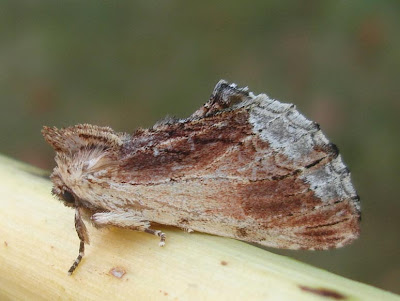Made the most of the warm evenings with some more moth trapping sessions at the park. Rewarded on the night of the 17th with this fine looking
garden tiger moth. This big colourful moth has been one of the top highlights in recent summers, usually during the third week of July, when one individual makes an appearance. Last year none were recorded because of the poor weather but prior to that, garden tigers had turned up in the four earlier years on the 20th, 21st, 22nd and the 17th of July.
Garden tigers used to be a widespread moth in the UK but according to a recent study the population has fallen by a staggering 93% over the last forty years. It is far from being a common garden moth these days.
This eye-catching
bordered beauty was a new species for the park with its orange and brown colouration. Although it has been recorded in several places across the county, it is listed as scarce. Normally found in woods and marshes the caterpillars feed on sallow.
The first
barred red moth for the park was found in the trap, a species normally associated with conifers.
One of the prettiest of moths is the
peach blossom with petal-like markings ideal for camouflage amongst the petals of brambles, the foodplant of the caterpillars. Although generally a widespread moth, it's not recorded often at the park, with only two or three previous records.
Luckily I recognised this distinctively patterned micro-moth, pictured above, before it may've got unwittingly stood on as it lay on the sheet beside the trap as the rare migrant
dark-bordered pearl - Evergestis limbata.This moth was first recorded in the UK only 20 years ago with the few sightings since then occurring in the south and south-eastern counties. It has also been found breeding at one or two southern locations too.
There have been several Essex records in recent years mainly in the north-east of the county, with a recent report from Frinton earlier this week.
This very colourful
V-pug moth was resting inside the trap, displaying the bright green colouration. The dark V shape is just about seen half-way along each wing. It is recorded here most years and is generally increasing in numbers.
Despite it being quite a common moth, the strikingly patterned
broad-bordered yellow underwing caught the eye. More so when it when it flashed the yellow markings on the hindwings.
The
white satin moth has silky, almost translucent wings, along with the distinctive black and white legs. It's noted at the park most years.
It was nice to see this very black coloured
dot moth, a freshly emerged individual. It's a common moth generally although here at the park, only one or two are noted each summer, usually well faded specimens.
Eighty species of macro moth were noted on the night of the 17th using two traps, the best night of the summer so far. Amongst the moths noted were
privet hawk, pine hawk, poplar hawk, small elephant hawk, elephant hawk, coronet, starwort, shark, nutmeg, poplar grey, scalloped oak, knotgrass, dun-bar, lunar-spotted pinion, dusky sallow, fen wainscot, herald, fanfoot and
bird's wing. Moths noted on other recent nights have included
July highflier, peacock, broad-bordered white, small angle shades, L-album wainscot, least carpet and
small scallop.
The recent hot spell has brought masses of
summer chafers out at dusk with several attracted to the moth traps too, such as this pair found mating on the sheet by the trap.
Bird activity seems to have been quiet at the park over recent days especially during the middle part of the day with the very hot temperatures of up to 28 degrees. A number of
swallows have been hawking over the park over recent days, with up to fifty birds noted. A few
sand martins have been passing through too with 300 stopping off briefly over the grazing fields on the 14th. Andy Field saw two
sedge warblers beside the fields on the same day too.
The young
kestrels were starting to leave their nestbox on the 14th with one of the four youngsters clambering and fluttering to the top of the tree. The parents have been seen at times hovering over the long grass of the park and seawall.
The main wader across the mudflats is the
black-tailed godwits with up to 300 birds noted, with a few also feeding on the park's pools. A
whimbrel flew over the fields whistling on the 14th and a
greenshank called as it passed by the park on the 17th.
Yellow wagtails have been noted most days with seven birds flying onto the fields on the 16th. A
Mediterranean gull flew over the park on the 17th and
common tern has overflown the park a couple of times too. Dave Allen reported the first returning
knot on the mud on the 14th.
Butterflies enjoying the heatwave have included the first
hedge browns on the 16th, lots of
meadow browns, ringlets, small skipper, Essex skipper, speckled wood, small tortoiseshell, comma,
small white, large white and
small heath. Steve Entwistle noted
ringlet and 2
gatekeepers near Meeting Lane on the 15th.The small number of dragonflies at the park have been a few
emperors and the
ruddy darters.
An
adder slid across the grass in the car park on the 17th, two were seen in their usual spot on the 16th and a
grass-snake was seen briefly as it disappeared off a path on the 14th. The
black rabbit is still occupying the same bit of grass near the car park having been first spotted here almost three months ago.


























































